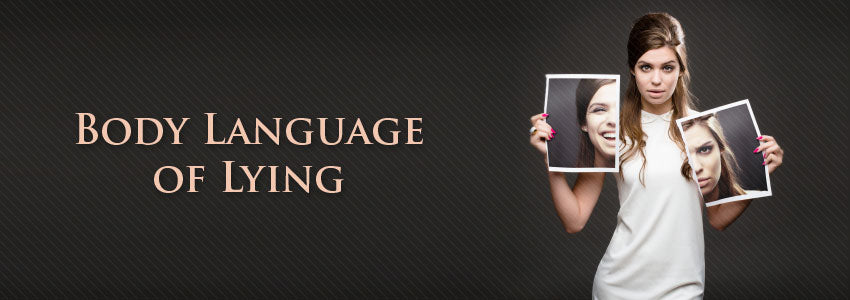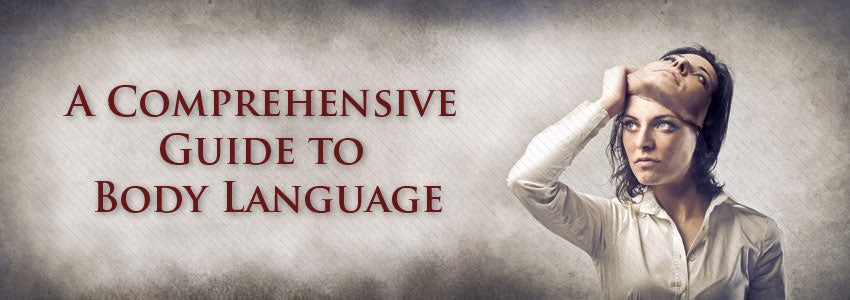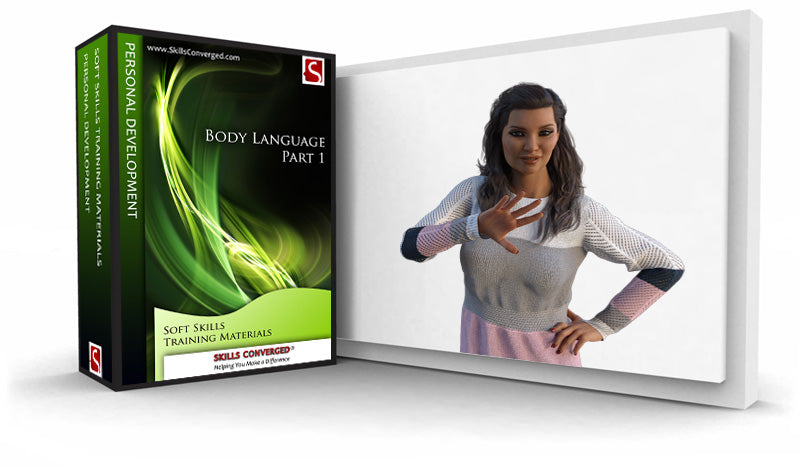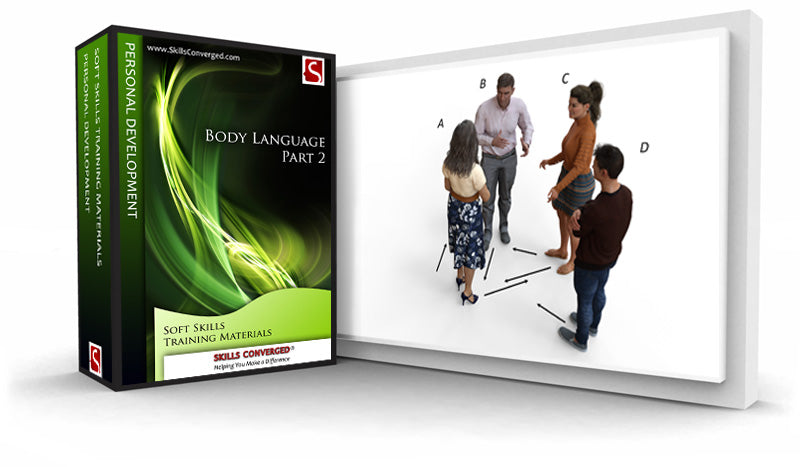
Body Language of Lying
“The man who lies to the world is the world’s slave from then on."
Ayn Rand
Why People Lie?
When it comes to body language, a great many of people are interested to learn about only one thing; deception. People seem to be obsessed about spotting liars and learning how to lie.
Whether it is morally wrong or socially unaccepted to constantly lie, we all tend to do it. Yes, that includes you and everyone else. Consider what you reply to the following question, “Darling, did you like the food I cooked tonight?” Imagine what happens if you didn’t like it and truthfully answered, “No, the chicken tasted like cardboard, it didn’t have enough sauce and it was so salty I feel almost sick!” The chances are that you will not get another cooked dinner for a long time! Here, a little stretch of the truth (otherwise known as white lie) will increase your chances of having another dinner in the near future!
Apart from this obvious application, there are of course other areas where people benefit from lying. Sales people who are desperate in selling something to you may deceive you by giving false information or skipping over a crucial data. Some might actually be in a profession that requires lying, such as being a spy. An accused person who faces years in jail may have a huge incentive to lie and walk away. In short, the moral issues that stop people from lying are relative; when the stakes are high anything goes.

Charming or Deceptive?
Ever since humans developed language, they learned how to use it to lie. To counteract lying, societies developed rituals and social rules that members of each society had to adhere to if they wanted to be part of it. In fact this was how religion was born and along came strict rules on lying and specific punishment for those who lied (in this world or after they died). This coevolution of language and ritual has eventually led to the sophisticated societies of today with complex culture and norms on lying. Right from childhood children are told not to lie, but their parents’ behaviour is not necessarily consistent. A mother may tell her child not tell dad anything about the surprise birthday cake in the fridge and the planned party; practically the child is told to lie. The contradiction stays with us to adulthood. Deception is all around us and we seem to constantly think about being deceptive when it suits us and when we think it is appropriate to use.

Hence, being able to successfully spot non-verbal signals associated with lying is something that just about everyone is interested in. The question however is whether detecting a lie is actually possible.
Can You Spot Lies?
Among body language researchers, there seem to be two camps; one camp believes that there are gestures associated with lying and if observed in clusters one can realise if a person is lying. A great representative of this camp is Allan Pease (Pease 2004) who has categorised many of these gestures such as touching the nose, scratching the neck, grabbing the ear, rubbing the eye and so on. The other camp believes that there is no single non-verbal indicator that conclusively suggests someone is lying (Matsumoto et. al., 2011). This group believes that reading such gestures such as nose rubbing, etc. is meaningless simply because those who are good at lying know all about it and can deceive the rest of us easily. This camp is perhaps best represented by Joe Navarro along with Paul Ekman, Matsumoto and Aldert Vrij (Navarro 2008).
Consider the following points raised by the second camp. One of the signals that might indicate someone is lying is eye avoidance. As always this signal should be taken only in conjunction with others to decide if someone is lying; something that the first camp also agrees on. Researchers such as Aldert Vrij have found that those that habitually lie are more likely to engage in greater eye contact than actually avoiding it (Vrij 2008). These are people such as anti-socials, Machiavellian personalities and those who make a living out of lying. The reason is that since they know everyone is looking for this behaviour to catch them out, and since they really care not to be caught, they over compensate their eye contact avoidance by actually looking into people’s eyes more often than people normally do.
Hence, if you want to primarily rely on something like eye contact to decide if someone is lying, you could be easily deceived by a person who is good at lying, especially if his quality of life strongly depends on it (like staying out of jail).
To answer the main question on whether you can spot lies by observing body language, perhaps it all depends whether you know the person or not. If you know the person, know their history, understand the pattern of their behaviour and pay attention to certain non-verbal signals along with what they say as a whole, you can form an opinion on whether they lie or not. On the other hand, if you don’t know the person, the environment is noisy, are dealing with a potentially good liar, the stakes are high, the person is stressed or drunk, then the non-verbal signals alone may not be a good indicator. You will need to consider more extensive evaluation to decide if they are lying.

Would you trust this man?
Nevertheless, it is still useful to know the standard lying gestures so in case the circumstances are appropriate for their use, you can take advantage of this knowledge along with other signals such as verbal statements, character and history. In a way, the aim is to look for emotional leakage. This is a term used to describe the unconscious expression of supressed emotions which can occur when a deceiver experiences intense emotions. Spotting this leakage can help you to decide if the person you are communicating with is lying or not.
The following guides provide a summary of the most common gestures known to be associated with lies.
Common Lie Gestures
In general, the vast majority of lie gestures are associated with stress. In other words, when stressed we show certain non-verbal signals. You can use these non-verbal signals to conclude that someone is stressed perhaps because they are lying. However, bear in mind that this is not always conclusive; a person might show signs of stress not because they are lying but simply because they are in a stressful situation, such as being arrested or being accused of a crime. Use these signals with care and in context:
Touching the Nose
Non-Verbal Signal
- This can be several touches and rubs on or below the nose.
What Does it Communicate?
When stressed or when thinking hard, more blood is pumped into the brain as the brain needs more oxygen to perform more computations and also to cool down. The pumped blood dilates the blood vessels in the nose. This leads to a sensation of an itch which we address of by scratching our nose leading to this classic gesture.
Be careful not to interpret every scratch attempt as a sign of lying. Sometimes a person may scratch their nose strongly simply because it itches!
Touching the Eyes
Non-Verbal Signal
- Rubbing the eyes with a finger.
What Does it Communicate?
Note that this gesture is different from rubbing the eyes with a closed fist which is usually an indication of tiredness.
Rubbing the eyes usually suggests that the person unconsciously wants to stop looking at the outside world, perhaps because he has been deceitful and is lying. A liar may prefer not to see the face of the person he is lying to (because he is ashamed) and may unconsciously close his eyes.
Blinking Rate
Non-Verbal Signal
- Blinking repeatedly over a specific amount of time.
What Does it Communicate?
Blink rate is correlated with stress levels. The more a person blinks in a given time, the more likely that he is stressed. A stressed person could be a liar. An interesting research was carried out by Joe Tecce on the relationship between blink rate and a US presidential candidate’s success in a race. The data shows that the faster blinker in the presidential debates has lost every election since 1980 (Newsweek 1999).
Touching the Neck
Non-Verbal Signal
- Stretching the neck
- Adjusting the collar
- Fixing the tie
- Touching the back or sides of the neck
- Touching the suprasternal notch (the dip in front of the neck)
- Touching the necklace
What Does it Communicate?
Touching or covering the neck is particularly common when threatened. As with many body language signals, they are most expressive and meaningful when a person is emotional. Touching the neck is carried out differently between men and women.
- For men. Men tend to grasp the front of the neck and in the process stimulate the nerves such as vagus nerves and the carotid sinus. Sometimes they use a few fingers to rub the sides or the back. The gesture stimulates the area and has a calming effect. It can even reduce the heart rate.
- For women. Women tend to cover the suprasternal notch in front of their neck. They may touch the side of the neck lightly. Sometimes this gesture is shown by touching, twisting or playing with a necklace.
These gestures usually suggest doubt, feeling threatened, insecurity and deception. Pulling the collar could also be because of feeling hot or sweaty which in turn can be due to lying. Again, every neck touch is not an indication of lying, it is only a clue.


Touching the Mouth
Non-Verbal Signal
- A finger is placed on the mouth
- Both fingers are placed on the mouth
- Most of the hand is placed on the mouth
What Does it Communicate?
Covering the mouth can be carried out unconsciously as a way to stop the mouth saying a lie. When children lie, they tend to cover their mouth, feeling ashamed that they are doing something wrong and wanting to physically stop the words from coming out. We tend to carry a more subtle version of this gesture with us to adulthood.
A person may cover the entire mouth with one hand, or use a more subtle version of just touching the lips with one or more fingers. The signal may still indicate that a person is saying something he thinks he should not say.
Hiding the Hands
Non-Verbal Signal
- The hands are hidden from view, perhaps held back behind, are blocked by a desk or are placed in pockets.
What Does it Communicate?
We unconsciously and instinctively become suspicious when we cannot see someone’s hands. The hands might be carrying something threatening. This can make us uncomfortable and distrustful.
If you don’t see the hands, it doesn’t necessarily mean that the person is lying or is up to something. Just be aware of your own potentially unconscious reaction to hidden hands while looking for other signals to evaluate the situation. Equally well, be careful not to hide your own hands while interacting with others.
Using Ventilators
Non-Verbal Signal
- Cooling the head
- Male. Combing through hair several times in quick succession
- Female. Lifting up the hair to let air through the neck
- Pulling on shirt buttons to lift it away from skin in an attempt to let air in
- Pulling on the collar of a shirt to let air in
- Lifting a hat up or tilting it sideways to cool down the head
What Does it Communicate?
We use ventilators when we are facing issues or there is something that we need to deal with. The stress makes us feel hot and ventilators are used to keep us cool. It doesn’t always mean that a person is lying; it just means that they are stressed.
Ventilating gestures should be used in context. You should always consider the environment as well as what a person has gone through. It is always possible that someone is feeling hot because of the weather, a malfunctioning air conditioner, being in a new hot climate they are not used to or just after running to make an appointment on time.

Delaying
Non-Verbal Signal
- Talking slowly when answering questions. To buy time, a person might repeat a question before answering it.
- Creating distractions to delay an explanation or skipping it altogether. Examples are:
- Pretending to adjust cloth
- Showing sudden interest in something superficial
- Suddenly remembering something else and wanting to shift the conversation to the new topic
- Making eye contact with a third party in an attempt to invite him over and hope to distract and change the conversation.
What Does it Communicate?
A liar needs time to think the situation through. He wants to gain time to make his lie convincing and will use any number of body language tricks to delay his explanation or answering questions.
Talking Fast
Non-Verbal Signal
- Talking rapidly and quickly, usually not allowing anyone else to talk.
What Does it Communicate?
By talking quickly a person can say a lot but also confuse and distract the listener. Their aim is to distract from the main issue and move on to another topic.
This technique is particularly common with sales people, especially those who make a living out of lying. A salesperson might talk about many details without ever covering crucial aspects or major shortcomings of a product or offer. The rapid talk can confuse and distract a would-be buyer and prevent him from thinking about the issue or asking about critical questions.
Eye Contact
Non-Verbal Signal
- Avoiding eye contact
- Glancing away while talking
- Making prolonged eye contact
- Intense gaze
What Does it Communicate?
When it comes to detecting lies, eye contact is perhaps the most controversial. Traditionally, lack of eye contact is seen as a clue that a person is lying. However, this is not universally true; some people (such as Africans or Latin-Americans) may avoid eye contact to show respect to authority (see Body Language Myths).
Since avoiding eye contact has been widely believed to be associated with lying, some go the other way and make more eye contact than necessary. In addition, a liar may glance away before answering and then quickly look back to catch your reaction to his answer.
In any case, eye contact should be interpreted carefully. It should always be used in conjunction with other signals in a cluster to form an opinion.
Tight Lips
Non-Verbal Signal
- The lips are tightly pressed together.
What Does it Communicate?
When we are feeling worried, threatened, or afraid or generally feel a negative emotion, we tend to compress out lips until they almost disappear. When you see someone with tight lips, it suggests that the person is under stress. You will then need to use other signals in conjunction with this to see if the person is being deceptive or lying.
Disappearing Neck
Non-Verbal Signal
- The shoulders are raised on both sides of the neck, creating an effect that makes the neck disappear.
- Sometimes the shoulders are raised all the way to the ears.
What Does it Communicate?
With this posture, a person is trying to protect his neck. It is a sign of being under stress or being anxious. It also suggests general lack of confidence and might mean the person has been deceptive and is now afraid to be caught.
Comparison between Liars and Truth-Tellers
Lying |
|
Spend more time thinking than just relying on memory to answer questions |
|
Are more likely to touch their body as they are stressed and anxious |
|
Are likely to have less eye contact (feeling guilty) or more eye contact (needing to over compensate). |
|
Appear observant, watching you closely to see if you have accepted their statements |
|
May unconsciously adopt a defensive body posture to protect themselves |
|
May talk less (to give less detail) or talk a lot more (to fill the gap and confuse) |
|
May use more frequent filler words such as “Ah” and “Em” while thinking |
|
Keep repeating questions to gain time so they can think |
|
Are likely to use long pauses to force the other person to talk |
|
Are likely to dodge sensitive questions and aim to shift the conversation to a different topic |
Telling the Truth |
|
Are quick to answer |
|
Have a comfortable posture and seem to be at ease to talk about the topic |
|
Talk at their normal speed, without rushing or feeling the need to pause and think hard |
|
Show their palms and have a generally open posture |
|
Seem to be happy to stay on a topic and talk about it as required |
References:
Matsumoto, D., & Hwang, H. S., et. al. (2011) “Evaluating truthfulness and Deception: New tools to aid investigators”, FBI Law Enforcement Bulletin, (June): 1-9.
Newsweek (1999) “In the blink of an eye”, Newsweek, October 21, 1999.
Navarro, J. (2008) “What Every Body is Saying”, New York, NY: HarperCollins Publishers.
Pease B., Pease A. (2004) “The Definitive Book of Body Language”, New York, NY: Bantam Books.
Vrij, A. (2008) “Detecting Lies and Deceit: Pitfalls and Opportunities”, Wiley-Blackwell; 2nd Edition, ISBN-13: 978-0470516256

All Articles in the Series
A Comprehensive Guide to Body Language
Origins of Humans and Body Language
How to Read People Using Their Body Language
How to Influence Your Emotional State Using Body Language
Body Language Across Different Cultures
Body Language of Defensive Attitude
Body Language of Good First Impressions
How to Improve Personal Impact
Continue Reading the Body Language Series..
Body Language Guide Article IndexBody Language Training Materials
Body Language Exercises
Explore our collection of free body language training exercises and articles:



Use this body language exercise at the beginning of a session before covering non-verbal communication. The aim is to find out how much delegates already know about this topic and...
The aim of this exercise is to get the delegates think about body language and gestures and observe how such signals can be instrumental while communicating. The training exercise illustrates...
This is an exercise in communication with the aim to increase awareness of body language and non-verbal communications.







